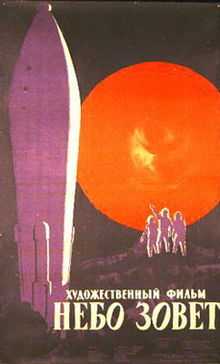Nebo Zovyot
| Nebo Zovyot | |
|---|---|
 Theatrical poster | |
| Directed by | Valery Fokin |
| Produced by |
Mikhail Karyukov Aleksandr Kozyr |
| Screenplay by |
Aleksei Sazonov, Yevgeni Pomeshchikov with Mikhail Karyukov |
| Music by | Yuliy Meitus, performed by Vyacheslav Mescherin |
| Cinematography | Nikolai Kulchitsky |
| Edited by | L. Mkhitaryyanch |
Production company | |
Release dates |
|
Running time | 77 min. |
| Country | Soviet Union |
| Language | Russian |
Nebo Zovyot (Russian: Небо зовет, translit. Nebo zovet, lit. The Sky Calls or The Heavens Beckon) is a Soviet science-fiction feature film, produced by Aleksandr Kozyr and Mikhail Karyukov, and filmed at the Dovzhenko Film Studios in 1959.
It premiered September 12, 1959.
Synopsis
A Soviet scientific expedition is being prepared as the world's first mission to planet Mars. Their space ship Homeland has been built at a space station, where the expedition awaits the command to start.
An American ship Typhoon experiencing mechanical problems arrives at the same space station, secretly having the same plans for the conquest of the Red Planet. Trying to stay ahead of the Soviets, they start without proper preparation, and soon are again in distress.
The Homeland changes course to save the crew of Typhoon. They succeed, but find that their fuel reserves are now insufficient to get to Mars. So Homeland makes an emergency landing on the asteroid Icarus passing near Mars, on which they are stranded.
After an attempt to send a fuel supply by unmanned rocket fails, another ship Meteor is sent with a cosmonaut on a possibly suicidal mission, to save the stranded cosmonauts.
Cast
- Ivan Pereverzev — scientist Eugene Kornev
- Alexander Shvoryn — engineer Andrey Gordienko
- Constantine Bartashevich — astronaut Robert Clark
- Gurgen Tonunts — astronaut Erwin Verst
- Valentin Chernyak — cosmonaut Gregory Somov
- Viktor Dobrovolsky — space station chief Vasily Demchenko
- Alexander (Alla ) Popov — Vera Korneva
- Taisia Litvinenko — doctor Lena
- Larisa Borisenko — student Olga
- Leo Lobov — cameraman Sasha
- Sergey Filimonov — writer Troyan
- Maria Samoilov — Clark's mother
- Mikhail Belousov — ( uncredited )
Crew
- Screenwriters — Alexei Sazonov, Evgeniya Pomeschikov
with the participation of — Mikhael Karyukov - Artistic director — Timofej Liauchuk
- Staging — Alexander Dovzhenko, Mikhael Karyukov
- Director of photography — Nikolai Kulchitskii
- Art director — Yuri Shvets
- Composer — Julij Meitus
- Sound engineer — Georgij Parahnikov
- Director — Valery Fokin
- Mounting — L. Mkhitaryants
- Costume — G. Glinkova
- Makeup artist — E. Odinovich
- Combined shooting operators — Franz Semyannikov, N. Ilyushin
- Artists — Yuri Shvets, G. Loukashov
- Consultant — corresponding Member of the USSR Academy of Sciences — Abnir Yakovkin
- Designer — Alexander Borin [1]
- Editors — Renata Korol, A. Pereguda
- USSR State Orchestra
Conductor — Benjamin Tolba - Экспериментальный ансамбль электромузыкальных инструментов
(Experimental Electronic Music Ensemble)
Director — Vyacheslav Meshcherin[2] - Production manager — Tatiana Kulchitskaya
U.S. re-edits
In 1962, Roger Corman and the young Francis Ford Coppola produced an English-language re-edit of the film for U.S. release, entitled Battle Beyond the Sun. They removed the US/Soviet conflict, blotted out all the Russian writing, replaced scenes showing models and paintings of Soviet spacecraft with scenes showing NASA ones, replaced the names of all the actors to the names of the people who did the overdubbing, and injected scenes with monsters. In all, the edit is 13 minutes shorter than the original.[3] The film was distributed by American International Pictures.[4]
Some space scenes from Nebo Zovyot also appear in Corman's 1965 film Voyage to the Prehistoric Planet. (Most of the scenes in that film are taken from another Soviet science-fiction film, Planeta Bur).
Related facts
Nebo Zovyot was released two years after the launch of the first artificial satellite Sputnik 1 and two years before the first manned flight into space by Yuri Gagarin.
Stanley Kubrik's 1968 film 2001: A Space Odyssey, used drawings and graphics solutions from Nebo Zovyot created by the fiction artist Yuri Shvets.[4]
Nebo Zovyot was re-released in Germany as Der Himmel ruft June 15, 2009. Furthermore, the film was officially translated into Hungarian and Italian .[5]
References
Outside sources
Небо зовет Full video and other info at KinoFilm.tv